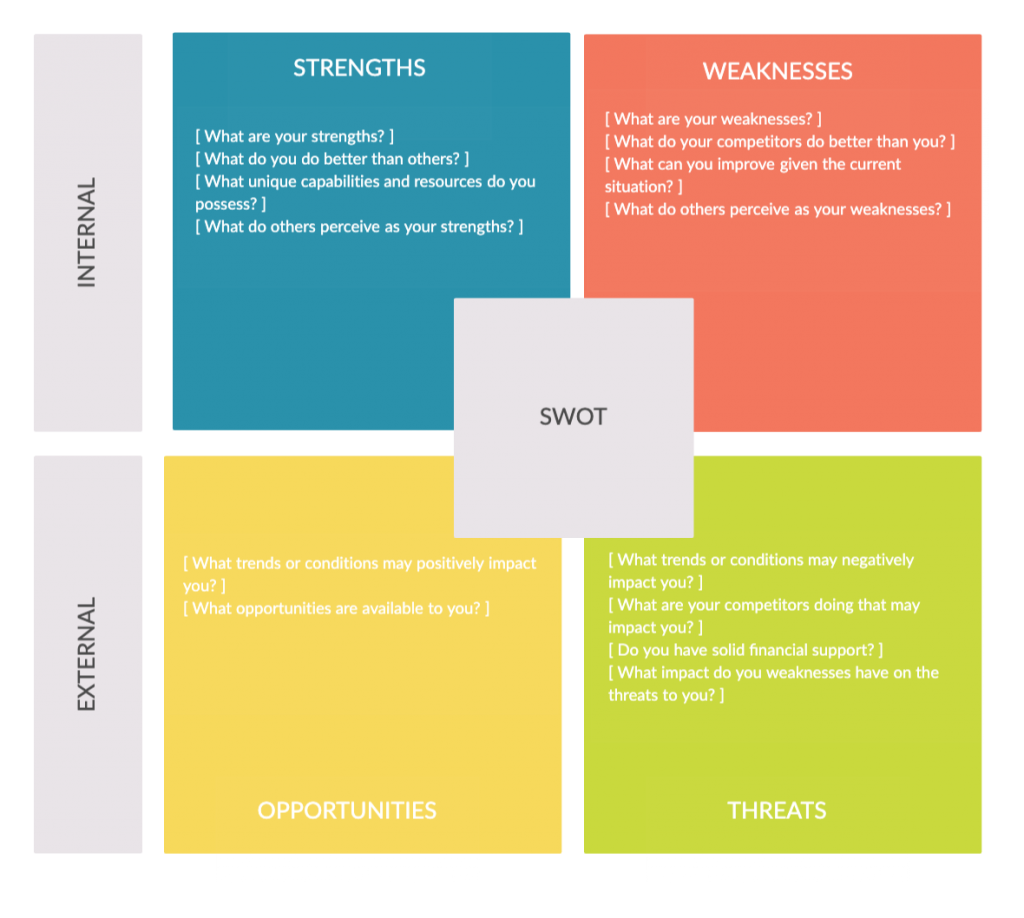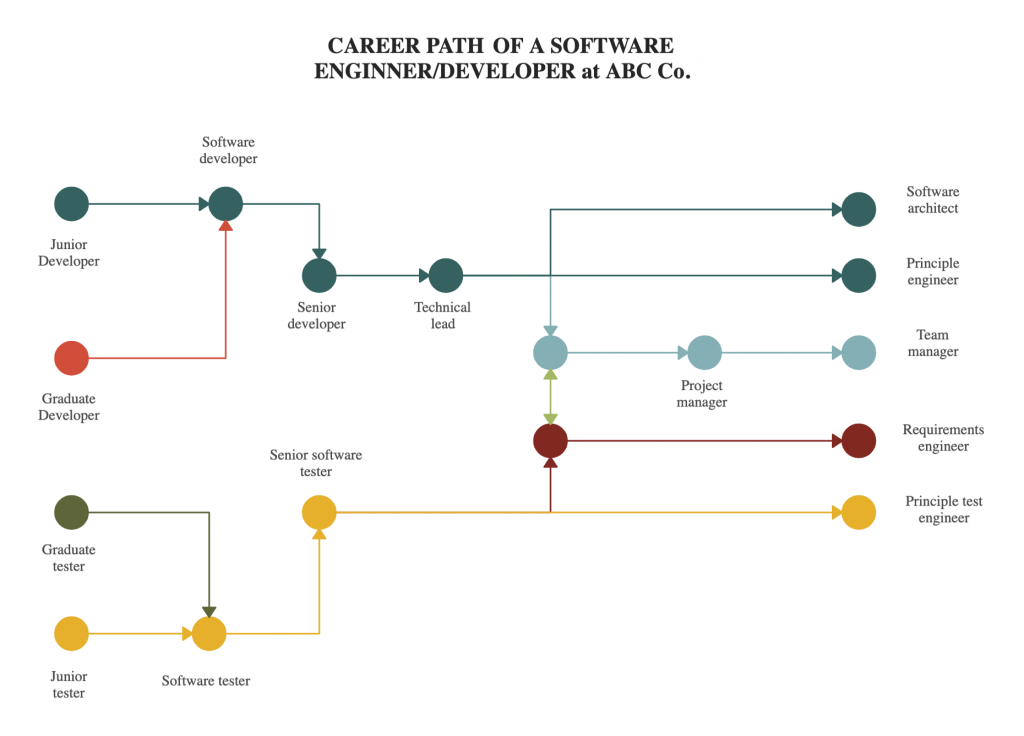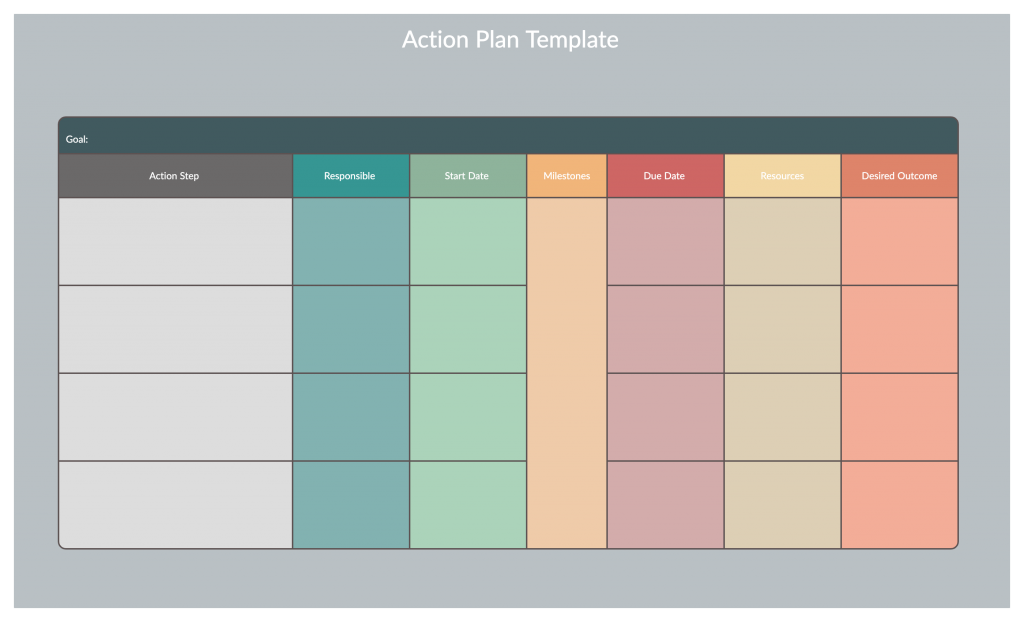COVID-19 has pushed companies to rethink their approach towards employee training and professional development. While the need for creating effective training and development programs is still persistent, perhaps even more so than ever, carrying them out remotely has become a challenge.
Professional development is essential for engaging and retaining employees. And in this post, we’ll discuss 7 online strategies that can be applied toward the professional development of your remote team.
Remote Career Development Strategies
Conduct an Employee Assessment
In order to help employees with their professional development, team managers should first understand their needs, strengths, weaknesses, potential, and skills.
A tool as simple as a SWOT analysis can be very effective in conducting this assessment. It can be used effectively to focus on employees’ strengths, weaknesses, opportunities (their potential), and threats (i.e. risks).

Share the Creately template above with your team and get them to conduct a self-evaluation online. If your assistance is required, you can connect with them via Creately in-app video conferencing and discuss together.
This activity can help the employees understand themselves better and help the manager identify where they stand in terms of their career and their future potential.
Launch a Mentoring Program
Whether the employee is the mentor or mentee, such a partnership can help advance their careers. It creates opportunities for improving communications and leadership skills, learning new perspectives, and growing in their role.
Set Clear Goals and Expectations
Based on the gaps in their current knowledge or experience, set the employees specific, attainable, and measurable goals.
A career development plan is essential in this step. It helps the manager map out the employees’ short-term and long-term goals pertaining to their current and future job roles, and understand the experiences (both formal and informal) they need to achieve their goals.

Incorporate their input during the process of mapping the career development plan, by discussing their current position and their ideal future. A clear vision of their career path is a great way to keep employees motivated.
As you set goals, you can help them further by developing their personal action plan which outlines the specific steps they need to take to reach each milestone.

Make Regular Check-ins
Regular check-ins allow you to keep track of how the employees are progressing with their development and training programs and career objectives. They also allow you to give regular feedback to keep them on track, guide them in the right direction, and discuss opportunities for their growth.
- In order to give employees the ideal learning opportunities, the manager needs to understand what they want. The best way to do this is by asking questions that allow you to gain more insight into them and their requirements.
- Discuss both successes and failures without judgment. Praise them on what they have been able to achieve so far and point out the steps they need to take to avoid failure.
- Even if their hard work didn’t have a positive outcome, it is important to acknowledge their effort. They are more likely to learn from their experience when they are not punished for their failures.
For productive discussions, rely on video calls, which is the closest to in-person communication you can get when working remotely.
Invest in the Right Online Courses
It’s easier now more than ever to find and provide the training your employees need with numerous online courses available at affordable prices. These resources can help them expand their knowledge and develop the skills they need for their professional development.
While they can complete these courses at their own pace, help them select the courses that best suit their needs based on the skill evaluation done earlier.
Some of the platforms that offer online courses for affordable rates include:
Real-time Online Training
This may include presentations, software or tool demonstrations, webinars, online lessons or discussions, etc. Real-time online training via video conferencing helps you walk your protegees through the learning material yourself as they watch, thus enhancing the effect it has on them.
It also allows the employees to present any concerns they may have on the spot, allowing them to get it resolved right away. This opens up more opportunities for learning.
Gather and store all resources and learning material in a central location that is easily accessible by the employees.
Create More On-the-Job Learning Opportunities
Assign them challenging tasks that match their potential.
This will open up opportunities for on-the-job learning opportunities by allowing them to learn new skills and expand their knowledge as they perform their tasks, with the guidance of their manager or a senior co-worker.
Make Time for Occasional Performance Reviews
Whether done monthly, quarterly, or annually, performance reviews have a lot to offer in the development of an employee. During a pandemic like COVID-19, you can prioritize on reinforcing your organization’s culture and its values on your remote employees over ranking their performance.
Given the circumstances and physical, mental, and emotional environmental conditions your employees are operating under, it’s also important to show more compassion and empathy.
Have heart-to-have conversations with poor performers on issues they are struggling with and offer your advice on how to overcome these challenges. Also, make sure to acknowledge the high performers for their effort and successes.
Got More Tips on Professional Development for Remote Teams?
Working remotely doesn’t mean a lack of opportunities for career development. With remote working and work from home options having become increasingly popular, developing remote-friendly professional development strategies are essential to retain and engage employees. (For this you can use employee engagement action plan)
We’d love to know your experience on professional development for remote teams. Let us know in the comments section below.
This post is part of the Creately’s series of working from home tips and best practices. More topics include
- The Practical Guide to Working from Home as a Team
- The Essential Guide on How to Brainstorm Online
- How to Make Working from Home Teams Collaborate Better
- The Ultimate Guide to Conducting a Successful Remote Interview
- Remote Employee Onboarding Best Practices
- 5 Powerful Collaboration Tools for Working from Home Teams
- How to Train Remote Employees | Best Practices and Tools
- A Manager’s Guide to Remote Team Management
- How to Avoid WFH Burnout: Causes, and Preventions
- Essential Cybersecurity Tips for Working from Home Employees
- 4 Ways You Can Use Creately to Enhance Remote Collaboration




